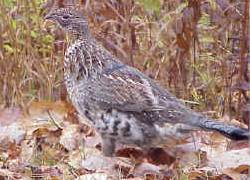Difference between revisions of "Field Guide/Birds/Bonasa umbellus"
| (7 intermediate revisions by the same user not shown) | |||
| Line 1: | Line 1: | ||
<table border="1" cellspacing="0" align="right" cellpadding="2" style="margin-left: 0.5em"> | <table border="1" cellspacing="0" align="right" cellpadding="2" style="margin-left: 0.5em"> | ||
<tr><th align="center" bgcolor=pink>'''Ruffed Grouse'''</th></tr> | <tr><th align="center" bgcolor=pink>'''Ruffed Grouse'''</th></tr> | ||
| − | <tr><td align="center">[[image:RuffedGrouse23.jpg|Photo: Grouse]]</tr></td> | + | <tr><td align="center">[[image:RuffedGrouse23.jpg|Photo: Ruffed Grouse (grey phase)]]</tr></td> |
<tr><th align="center" bgcolor=pink>'''[[Scientific Classification]]'''</th></tr> | <tr><th align="center" bgcolor=pink>'''[[Scientific Classification]]'''</th></tr> | ||
<tr><td><table align="center"> | <tr><td><table align="center"> | ||
<tr><td>{{Regnum}}: </td><td>[[Animal]]ia</td></tr> | <tr><td>{{Regnum}}: </td><td>[[Animal]]ia</td></tr> | ||
<tr><td>{{Phylum}}: </td><td>[[Chordate|Chordata]]</td></tr> | <tr><td>{{Phylum}}: </td><td>[[Chordate|Chordata]]</td></tr> | ||
| − | <tr><td>{{Classis}}: </td><td>[[ | + | <tr><td>{{Classis}}: </td><td>[[Aves]]</td></tr> |
<tr><td>{{Ordo}}: </td><td>[[Galliformes]]</td></tr> | <tr><td>{{Ordo}}: </td><td>[[Galliformes]]</td></tr> | ||
<tr><td>{{Familia}}: </td><td>[[Grouse|Tetraonidae]]</td></tr> | <tr><td>{{Familia}}: </td><td>[[Grouse|Tetraonidae]]</td></tr> | ||
| − | <tr><td>{{Genus}}: | + | <tr><td>{{Genus}}:</td><td>'''''Bonasa'''''</td></tr> |
| − | <tr><td> | + | <tr><td>{{Species}}:</td><td>'''''umbellus'''''</td></tr> |
| + | </table> | ||
| + | <tr><th align="center" bgcolor="pink">'''[[Binomial name]]'''</th></tr> | ||
| + | <tr><td align="center">'''''Bonasa umbellus'''''<br><small>([[Carolus Linnaeus|Linnaeus]], [[1766]])</small></td></tr> | ||
</table> | </table> | ||
| − | |||
| − | |||
| − | |||
The '''Ruffed Grouse''', ''Bonasa umbellus'', is a medium-sized [[grouse]]. | The '''Ruffed Grouse''', ''Bonasa umbellus'', is a medium-sized [[grouse]]. | ||
| − | + | Ruffed Grouse have two distinct color phases, grey and red. In the grey phase, adults have a long square brownish tail with barring and a black band near the end. The head, neck and back are grey-brown; they have a light breast with barring. The ruffs are located on the sides of the neck. The female is smaller with less obvious ruffs and a shorter tail. | |
Their breeding habitat is forests across [[Canada]] and the northern [[United States]] including [[Alaska]]. They nest on the ground in dense growth, usually near a log or tree trunk. | Their breeding habitat is forests across [[Canada]] and the northern [[United States]] including [[Alaska]]. They nest on the ground in dense growth, usually near a log or tree trunk. | ||
| Line 24: | Line 24: | ||
They are permanent residents. Some move short distances to denser cover for winter. | They are permanent residents. Some move short distances to denser cover for winter. | ||
| − | These birds forage on the ground or in trees. They are [[omnivore]]s, eating buds, leaves, berries and | + | These birds forage on the ground or in trees. They are [[omnivore]]s, eating buds, leaves, [[Berry|berries]] and [[seed]]s, but also [[insect]]s and even small [[frog]]s. |
This is the most wide-spread grouse in North America. The male is often heard drumming on a fallen log in spring on territory. When surprised, they may explode into flight. | This is the most wide-spread grouse in North America. The male is often heard drumming on a fallen log in spring on territory. When surprised, they may explode into flight. | ||
This is the state bird of [[Pennsylvania]]. | This is the state bird of [[Pennsylvania]]. | ||
| + | |||
| + | == External links == | ||
| + | * Ruffed Grouse Society (http://www.ruffedgrousesociety.org/ruffed_facts.asp) | ||
| + | * Ruffed Grouse call (http://www.mbr-pwrc.usgs.gov/Infocenter/Song/h3000ca.wav) | ||
| + | * Ruffed Grouse drumming(http://birds.cornell.edu/programs/AllAboutBirds/BirdGuide/Ruffed_Grouse_dtl.html#sound) | ||
| + | * Ruffed Grouse (Cornell) (http://birds.cornell.edu/programs/AllAboutBirds/BirdGuide/Ruffed_Grouse_dtl.html) | ||
| + | |||
| + | |||
| + | [[Category:mother | ||
| + | caca-dookie]] | ||
Revision as of 20:23, 26 April 2005
| Ruffed Grouse | ||||||||||||||
|---|---|---|---|---|---|---|---|---|---|---|---|---|---|---|
 | ||||||||||||||
| Scientific Classification | ||||||||||||||
| ||||||||||||||
| Binomial name | ||||||||||||||
| Bonasa umbellus (Linnaeus, 1766) |
The Ruffed Grouse, Bonasa umbellus, is a medium-sized grouse.
Ruffed Grouse have two distinct color phases, grey and red. In the grey phase, adults have a long square brownish tail with barring and a black band near the end. The head, neck and back are grey-brown; they have a light breast with barring. The ruffs are located on the sides of the neck. The female is smaller with less obvious ruffs and a shorter tail.
Their breeding habitat is forests across Canada and the northern United States including Alaska. They nest on the ground in dense growth, usually near a log or tree trunk.
They are permanent residents. Some move short distances to denser cover for winter.
These birds forage on the ground or in trees. They are omnivores, eating buds, leaves, berries and seeds, but also insects and even small frogs.
This is the most wide-spread grouse in North America. The male is often heard drumming on a fallen log in spring on territory. When surprised, they may explode into flight.
This is the state bird of Pennsylvania.
External links
- Ruffed Grouse Society (http://www.ruffedgrousesociety.org/ruffed_facts.asp)
- Ruffed Grouse call (http://www.mbr-pwrc.usgs.gov/Infocenter/Song/h3000ca.wav)
- Ruffed Grouse drumming(http://birds.cornell.edu/programs/AllAboutBirds/BirdGuide/Ruffed_Grouse_dtl.html#sound)
- Ruffed Grouse (Cornell) (http://birds.cornell.edu/programs/AllAboutBirds/BirdGuide/Ruffed_Grouse_dtl.html)
[[Category:mother
caca-dookie]]
